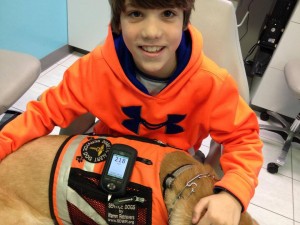 Dog detects high and low blood sugar
Dog detects high and low blood sugar
Like many boys, Matt Tokarski always wanted a dog. Last summer, Matt, his twin brother Gavin, and his two sisters got their wish when a 4-month-old purebred golden lab named Pilot became the newest member of the family. But Pilot is not just a pet; he arrived with a job and a mission. Matt, who just turned 10, has been living with diabetes the past four years. And Pilot is trained to detect when Matt’s blood sugar is abnormally high – or low – both potentially life-threatening situations.
“I don’t sleep. I check him every night at midnight and 3am at minimum,’’ says Matt’s mom, Kate Tokarski, who has learned what every parent of a diabetic child already knows: It is a 24/7 job and you have to become part pharmacist, mathematician, doctor and nurse. Every single carbohydrate Matt eats is accounted for and calculated. And before he went on an insulin pump three years ago there were 6 to 12 shots every day in addition to the numerous blood sugar checks.
“Diabetes, unfortunately it takes over the entire house. It’s a beast. Everything is about diabetes,’’ Kate said. Two years ago she read about alert dogs that could literally sniff out trouble with diabetics. She was skeptical until she went to visit a family that had one of the dogs.
“I was at their house, the child was at school a mile away and the dog alerted,’’ she said. “And the mom called the nurse and the nurse said, ‘Let me go check him.’ And the mom said to me, ‘Watch this. I guarantee before you leave the nurse is going to call me he’s low.’ And sure enough, 20 minutes later nurse called and said he’s low.’’
That launched their quest to get a diabetic alert dog for Matt that led them to Service Dogs by Warren Retrievers, which is located on 250 acres in Culpeper, Virginia, an hour and a half south of Washington, DC.
Dan Warren, who was diagnosed with Type 1 diabetes 10 years ago when he was 29 began training service dogs on his sprawling farm in 2009. “Canines for detection work have 220 million olfactory glands. Humans have five million olfactory glands.’’ He says the alert dog is one tool to help manage what is an invisible disease.
“They’re sensing from the core of the body: breath, saliva, heart, lung field, circulatory system, in essence the blood stream. So it is all a process of training the dog to zone in on that chemical imbalance, and alert to the individual or third party within that home that an impending blood sugar event, high or low, is about to occur.’’
Kate says there have been many times when Pilot has alerted, Matt’s blood sugar has been fine, but within 15 to 20 minutes it either spikes or tanks. The signal is that Pilot paws whoever he can find.
And while the dogs go through months of obedience training on the farm, Warren’s operation differs from others because it waits to train for high and low blood sugar until the dog is placed in a specific home. The training period lasts two years and will entail eight visits to the Tokarski’s home in Hopkinton by one of the Warren trainers. “The time, the commitment, the dedication, the responsibilities and the undertaking that this is is hard work, and it takes two parties: the organization and the recipient.’’
While Kate is doing the lion’s share of the training, Matt is heavily involved as well. He takes Pilot out when he needs to go and was the only one to feed him when he first arrived last summer. The game plan is to have Pilot go to school with Matt when the dog is fully trained.
Pilot knows now to get Matt’s glucose meter when he detects a high or low blood sugar and bring it to Matt or Kate. The dog also sleeps with Matt and will alert when there’s a problem by shaking the gate set up at the bedroom door.
All of this comes with a price. While Service Dogs by Warren Retrievers is a non -profit organization, it charges $25,000 to help cover its costs, which average more than $40,000 per dog, including everything from site visits over the two-year training period to hotels and airfare for the trainers. A lab’s average lifespan is 10 to14 years, and the working life as an alert dog is 10 to 11 years. Warren provides a lifetime healthcare warranty for any major medical issues. The family was able to raise the funds in five months.
Kate says it’s given the family something that has been elusive since Matt was first diagnosed.
“It’s not a cure, it’s not an answer to every problem that he has because diabetes is still very difficult. But it was another item in our tool kit to help him live a successful life.’’
If you want to see the video version of this story go to www.hummelspotlight.org. If you know of a person or organization who you think deserves the Spotlight, send an email to info@hummelspotlight.org


